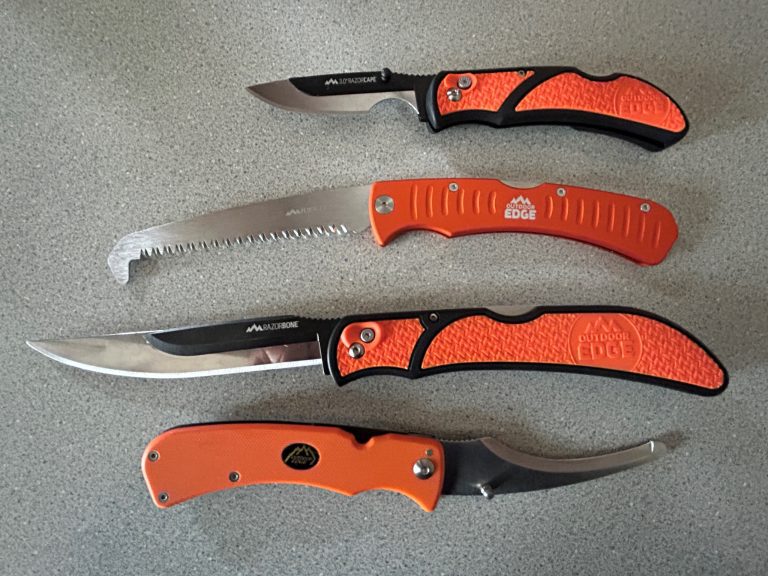Why I love a great hunting knife
I have fascination with knives. Even before I started hunting, I always liked knives and once I started hunting, I had even more reason to start buying, using and collecting knives. For as long as I can remember I typically buy a new knife or two before each hunting season. Over the course of time, I have seen numerous developments and even fads come and go with knives. I have seen different steels used to make knife blades along with different styles of blades and knife handles. I’ve used fixed blade knives, folding knives, knives with different handles including wood, antlers and plastics.
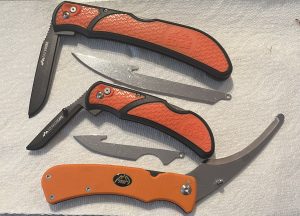
When I first started seeing knives with replaceable blades, I was somewhat skeptical of them. I had concerns about the strength of the blades and their durability. Plus, I had built a collection of “old faithfuls”! However, given my love of knives, I just had to try some exchangeable blade knives and was totally amazed at the razor sharpness and convenience of being able to change a blade out in the field.
In a quest to lighten the amount of gear I pack for hunts, I was very interested in trying out one of the new Outdoor Edge RazorGuide Pak when they first hit the market. Since starting to use this set of knives, I now typically leave all my other knives at home and use my RazorGuide Pak exclusively while out hunting with my family. Over the past few seasons, my kids and I have field dressed and skinned 1 moose, 2 elk, 7 mule deer and 9 whitetail deer and while we have gone through a few blades doing so, the knife handles in this set are still in awesome shape and will certainly help us process many more big game animals in the years to come.
RazorGuide – a 3 Pack of great tools (Buy here from Amazon)
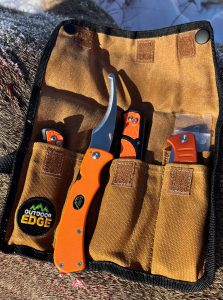
The RazorGuide Pak comes with 3 tools: a Flip N Zip Saw, RazorBone Knife and a RazorCape Knife. Rounding out the kit is a waxed cotton roll pack to hold the cutting tools, a collection of spare blades and a blade box to store blades when not in use. All pieces in this kit are also available individually.
The Flip N Saw is a compact folding saw that weighs 2.5 ounces. This saw is 5 inches long when folded and has a 4.4-inch 65Mn spring-steel blade. The teeth are a triple ground tooth pattern that create an aggressive cutting edge for penetrating through bone and wood. The 6061-T6 aircraft grade aluminum handle is anodized orange for high visibility in the field and finished with a thin rubberized coating for a secure, non-slip grip.
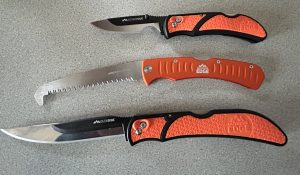
This saw comes in super handy for splitting the pelvis on a downed animal. I have also used it to trim branches to open up a shooting lane and to clear away twigs and undergrowth prior to taking filed photos.
The RazorBone Knife is a real work horse and is ideal for gutting and skinning any size big game animal from antelope to moose. The kit includes 1- 3.4-inch gutting blade, 2 – 3.5-inch drop point blades and 2 to-5-inch boning/filleting blades. I use the gutting and drop point blades while in the field and the boning/filleting blades at home while butchering. I have also used the boning/filleting knife to fillet some fish. Although this knife is a work horse, it weighs a mere 3.1 oz., folds to 6 inches.
The RazorCape Knife is a small but mighty folding knife. It is 4 inches long when folded and weighs 2.0 ounces. It features an easy open dual sided thumb stud for left or right-handed opening. The drop style blade is ideal for all skinning projects. When you need to make fine and intricate cuts such as when capping out a trophy animal, the capping blade with its special index finger cutout on the blade is tool of choice.

The knife handles on the RazorBone and RazorCape are made using textured Grivory in blaze orange. Grivory is a high-quality plastic material that is highly resistant to impact and heat. It’s corrosion-resistant and has a longer lifespan than other knife handle materials like wood and metal. The texturing gives the user grip when using the knife with wet or cold hands as well as when wearing surgical gloves. The blaze orange coloring allows you to easily find the knives should you drop them or set them down while performing field dressing tasks.
Interchangeable Blades – always sharp!
To change a blade on these knives is very simple. All you do is push a small button on the handle of the knife and slide the old blade off and then slide a new blade on. The process is so simple, yet the blades stay in place while in use. In addition, the knife handles feature a blade holder support on the top edge of the knife that gives the replaceable blade added strength and eliminates the blades from twisting and breaking. I also find the blade holder support is a great place to put your thumb or index finger if you need extra support or leverage.
The beauty of interchangeable blades is you can switch out a dull blade for a sharp one in mere seconds or you can switch out a to a different blade style while still using the same knife handle. While these interchangeable blades are super sharp and will often maintain their edge for skinning even the biggest of animals, there are times when you need to switch to a sharper blade right in the middle of your skinning job. Such was the case a couple of years ago on a bull elk I had taken. The elk was fresh out of wallow and covered in mud. The mud on the outer edge of his hide dulled the knife blades fairly quickly and I need to use three blades on him while skinning him and racing the rising temperatures. Yet the next day, we skinned a different bull elk using just one blade which remained sharp even after the skinning was done.
In current times, where CWD is present, using knives with interchangeable blades is a good way to ensure you always have a clean blade for each animal harvested. When hunting in areas where CWD is extremely prevalent, I will soak my blades and knife handles in a glass dish using a mixture of 50/50 bleach and water for 45 minutes. Then, I will rinse them off using fresh water, dry them and use them again. When doing so, I have not found any negative impact on the knife handles and blades in my RazorGuide Pak.
The waxed cotton roll pack has five pockets to keep all the tools and spare blades organized and easily accessible. This case can be rolled up and stuffed into a backpack or jacket pocket for easy carry. As well, it can be opened up and attached to your belt as open scabbard. Given the carry pouch has five pockets, I moved the Zip N Saw to the outer right front pouch and moved all my extra blades behind the saw in the back right pocket. Then, I added a ZipPro tool to the kit.
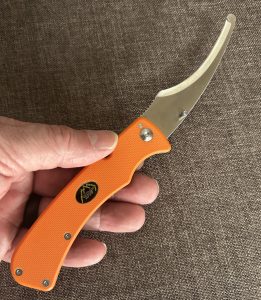
I added a ZipPro as it is an incredibly handy folding field dressing tool that I use to open up big game animals and to cut incision lines for skinning and capping. This tool only weighs 3.1 ounces, has a 3.5-inch blade and measures 4.5 inches when folded.
The Ultimate Field Dressing Kit
To operate this tool, all you need to do is make a small puncture in the hide and then insert the blunt tip of the ZipPro into the puncture with the sharp edge upwards. Once inserted this specialty knife can be run under the skin and on top of the meat to cut open the hide from the inside out. By cutting from the inside out, there is no hair loss from the hide and this helps keep your carcass clean. Also, the blunt tip does not damage any meat or internal organs during this process. My kids and I like to use one to open up the belly for field dressing and also to cut around and up the back legs to start the skinning process. This knife is also perfect to make the necessary cuts up the front legs to the brisket to make straight and clean cuts when capping an animal for mounting. On remote hunts where weight is an issue, this tool can also be used to make a clean/hairless incision around the hide in order for you to cut off the back portion of the hide so you only need to pack out the front half of the hide with the antlers for your trophy mount.
After using the Outdoor Edge RazorGuide Pak for the past few seasons, I can state that this is an incredible set of field dressing tools. With the addition of a ZipPro tool, I call it my Ultimate Field Dressing Kit.
Per our affiliate disclosure, we may earn revenue from the products available on this page. To learn more about how we test gear, click here.





